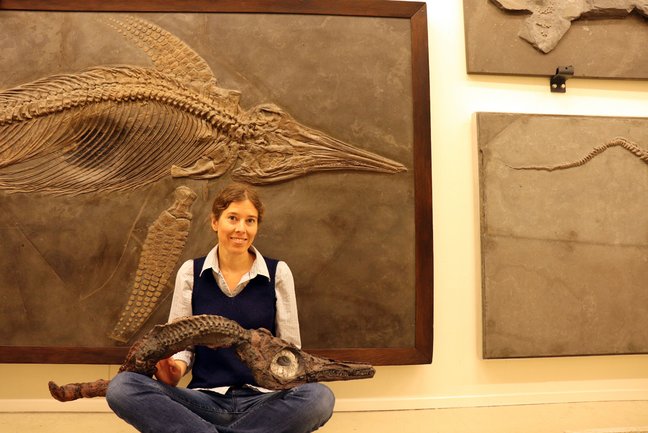Muiscasaurus ist eine ausgestorbene Gattung der Ophthalmosauriden Ichthyosaurier, die während der frühen Kreidezeit im heutigen Kolumbien lebten. Fossilien des Typus-Exemplars des Muiscasaurus wurden 2010 gefunden, bestehend aus einem Teilschädel und einigen Wirbeln mit Rippen. Ein Team aus Forscher*innen, darunter Erin Maxwell, Kuratorin bei uns am Haus und Mary Luz Parra Ruge, Direktorin beim Centro de Investigaciones Paleontológicas in Kolumbien benannte 2015 diese Überreste als neue Gattung und Art Muiscasaurus catheti.
Das Ausleihen der Fossilien ist aufgrund der Zerbrechlichkeit und des kolumbianischen Denkmalschutzgesetzes nicht möglich. Damit Erin in Deutschland weiter damit arbeiten kann, z.B. hinsichtlich anatomischer Vergleiche, wurde stattdessen ein Abguss angefertigt. Als Tausch wurde an das Centro de Investigaciones Paleontológicas in Villa de Leyva ein Abguss eines Stenopterygius aus dem frühen Jura Deutschlands geschickt.
Research international: Ichthyosaur cast
Muiscasaurus is an extinct genus of ophthalmosaurid ichthyosaurs that lived during the Early Cretaceous in what is now Colombia. The specimen was found in 2010, consisting of a partial skull and some vertebrae with ribs. In 2015, a team of researchers including Erin Maxwell, curator at our house, and Mary Luz Parra Ruge, director of the Centro de Investigaciones Paleontológicas in Villa de Leyva, Colombia, named these remains as the new genus and species Muiscasaurus catheti.
Borrowing the fossils is not possible due to their fragility and Colombian monument protection laws. So that Erin can continue to work with them in Germany, for example with regard to anatomical comparisons, a cast was made instead. In exchange, a cast of a Stenopterygius from the Early Jurassic of Germany was sent to the Centro de Investigaciones Paleontológicas in Villa de Leyva.
